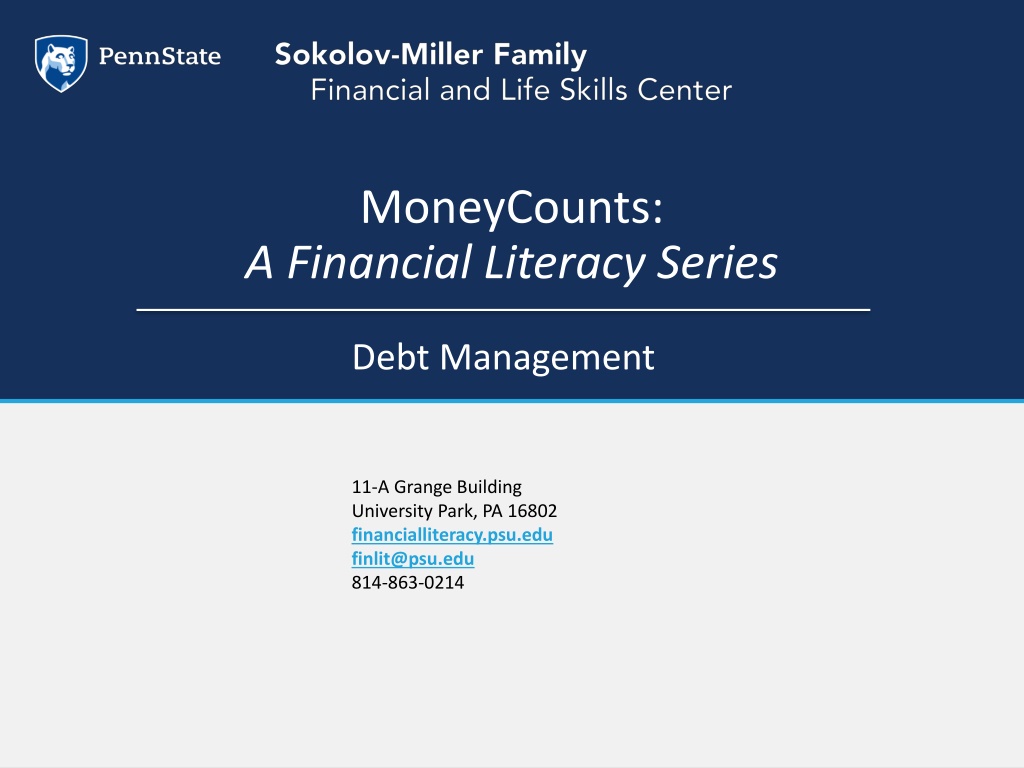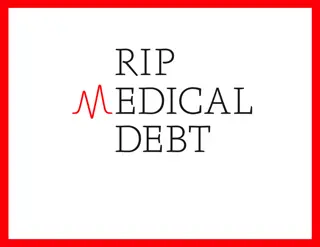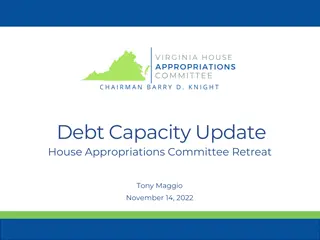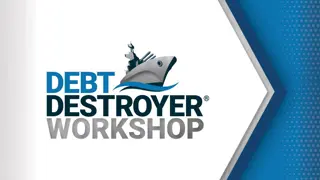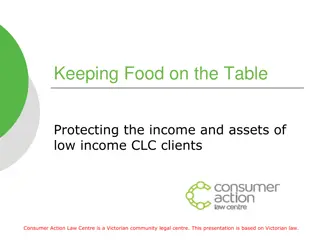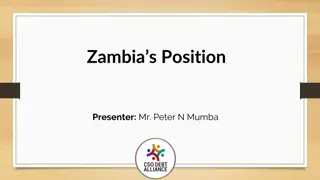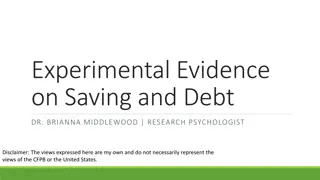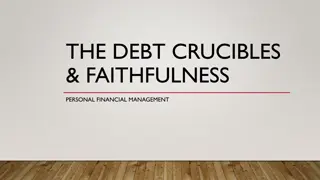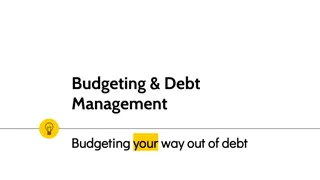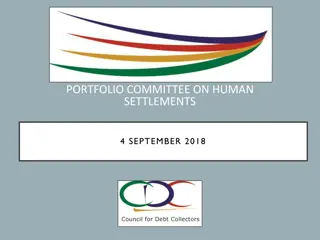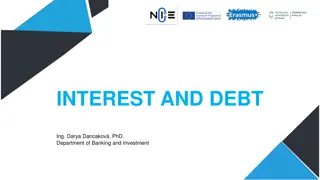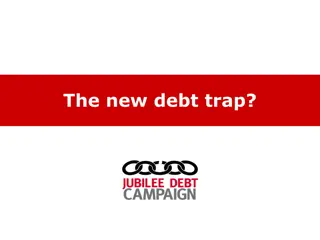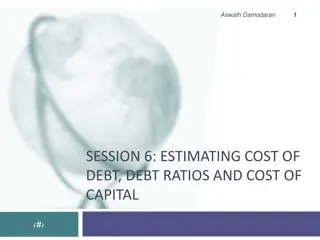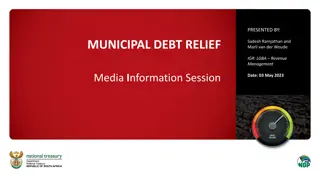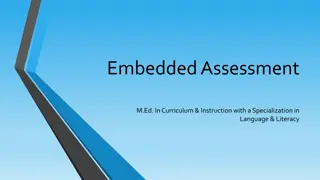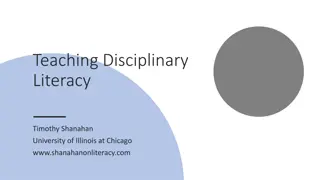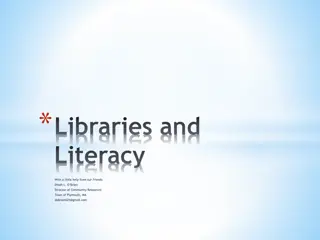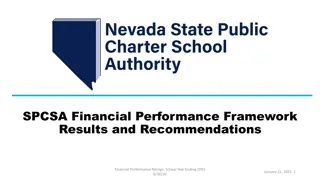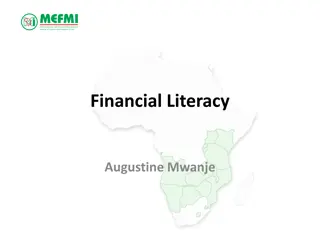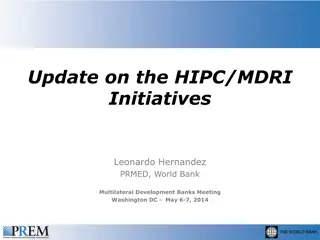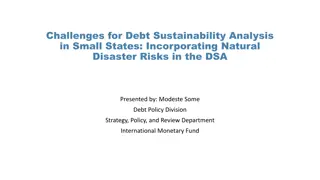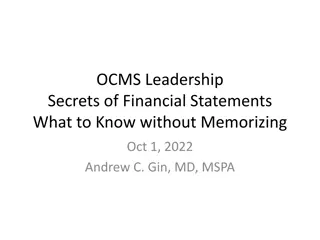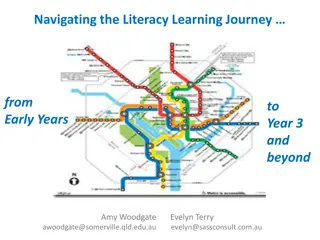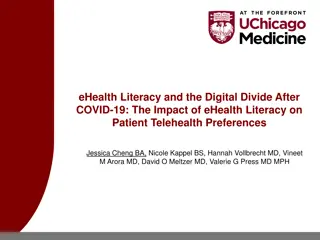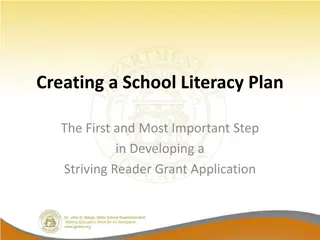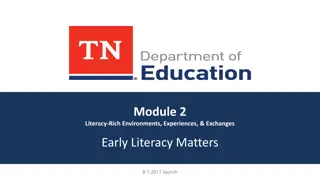Financial Literacy Series: Overcoming Debt Challenges
Many individuals face financial crises due to overwhelming debt burdens. Debt management is crucial for creating a realistic budget, developing a financial plan, and breaking free from debt shackles. Recognizing symptoms, making a plan, exploring debt management options, and learning to avoid scams are essential steps. Statistics highlight the average debt burdens of Americans and college students, emphasizing the importance of managing debts effectively to secure financial stability and future goals.
Download Presentation

Please find below an Image/Link to download the presentation.
The content on the website is provided AS IS for your information and personal use only. It may not be sold, licensed, or shared on other websites without obtaining consent from the author. Download presentation by click this link. If you encounter any issues during the download, it is possible that the publisher has removed the file from their server.
E N D
Presentation Transcript
MoneyCounts: A Financial Literacy Series Debt Management 11-A Grange Building University Park, PA 16802 financialliteracy.psu.edu finlit@psu.edu 814-863-0214
Many people face a financial crisis at some point in time. It can be overwhelming, but it also can be overcome! Debt management helps you build a realistic budget and make a financial plan to free yourself from being shackled with debts! Description
Recognize the symptoms of uncontrollable debt Make a plan to combat and manage your financial crisis Explore options in debt management Learn how to avoid scams Learning Outcome
DEBT How much debt is too much?
69 % of Americans are in debt by an average of $70,000. Consumers with the greatest amount of growing debt were those in the age group of 35 to 45, with roughly $108,000 in debt. People aged 45 to 55 were carrying $86,500 in debt. People aged 55 to 65 were saddled with $70,000 in debt. College students graduate with an average of $37,000 in student loans. Penn State Adult students graduate with an average of $40,000 in student loans. U.S. Census Bureau (Statistics)
66% of students who graduate each semester are carrying student loan debts. Average student loan debt: $35,639 (2012-2013) Adult students graduate: $40,000 (2012-2013) Penn State Student Aid Office (Statistics) Repayment of student loan debt ranges between 10-30 years depending on payment plan Average monthly payment on a standard 10 year plan is $400 - $700
Symptoms of overspending Having no significant savings Paying debt more than 10% of net income Paying the minimum amount on your credit card bill Paying late fees on bills Utilities are threatened to be disconnected Receiving collection dunning letters or phone calls Not getting ahead even with multiple jobs Being worried you might lose your home or car Having no financial goals in your life Stop! If
Overspending can lead to excessive debt Overspending makes it difficult to set and reach financial goals Overspending prevents building financial wealth College fund Retirement Vacation Overspending can ruin your financial reputation Overspending can push you into bankruptcy Danger of overspending
Back to basics! Needs Wants
Every penny counts! Buying one bottle of water a day $1.50 # of Days Amount Cost of one bottle of water 1.50 Cost per week 7 10.50 Cost per year 365 547.50 Cost in 10 years 3650 5,475.00 Cost in 20 years 7300 10,950.00 Cost in 30 years 10950 16,425.00 Net Pre-tax needed (30%Tax) 23,464.00 Gross
Re-do your budget! Recommended budgeting as a percentage of net income 1. Saving 10.00% 10.00% 10.00% 2. Housing 30.00% 10.00% 3. Utilities 5.00% 4. Food 20.00% 5.00% 30.00% 5. Transportation 10.00% 10.00% 6. Entertainment 5.00% 7. Debt 10.00% 5.00% 20.00% 8. Other 10.00%
Where to start? Review budget and minimum monthly payment Identify personal debt Identify outstanding debt Negotiate credit cards interest rates Eliminate/reduce High interest loans Freeze some cards
Know your rules To keep debt in check, follow the rule of 20/10 (excluding mortgage) Credit card Student loan Car loan Personal loan 20% of your yearly net income Debt Monthly Payment 10% of your monthly net income To Keep mortgage in check, follow this rule: Monthly payment, including insurance, tax, and interest should not be more than 30% of your net monthly income
Other options Depending on your level of debt, there are different options for different situations Debt Debt Debt Repayment Plans Consolidation Negotiation *Consider all options before Bankruptcy! Debt Bankruptcy Settlement
Debt Consolidation Taking one new debt to cover all debts New interest rate, terms of payment Reduce or eliminate all late fees and penalties to debtor Overall higher cost but easier monthly payments Fees of service required up front
Debt Negotiation Negotiating to adjust terms of debts The concept is to convince creditors to reduce the total amount of money owed in lieu of a set fee. The set fee is required to be paid up front Creditors are under no obligation to accept debt negotiation
Debt Repayment Plans Restructuring for easier monthly payments Usually higher interest rates Longer # years Higher overall cost Creditors are under no obligation to accept Fees for service required up front
Debt Settlement Offering % to settle the debts, a step before full bankruptcy, takes 3-5 years to complete and affects credit 7-10 years Acceptance of settlement is optional (It could be rejected by creditors) Fees and interest keep accruing while settlement is in process Cost of services is an added burden to the debts and is usually required up front
Bankruptcy (Last Resort) Bankruptcy Chapter 7: Liquidation Assets are sold to satisfy debts Gets rid of unsecured debts such as credit cards - Low income Chapter 13: Reorganization Income is used to satisfy debts - Repayment plan assets are kept Pays non dischargeable debts such as child support or alimony Student loans are not dismissible in a bankruptcy!
Avoid scams Federal Trade Commission Don t believe! They will promise they can reduce your debt to the point that you re paying pennies on the dollar for what you actually owe. They will promise that some of your debt will be eliminated entirely. They lie and tell clients that unsecured creditors do not sue debtors for non-payment. They claim they can remove negative information from your credit report.
Tough Economic Times Stop ALL spending you can LIVE without Stop Go back to basics! Stretch your savings. Do not deplete fast. Review Review your existing expenses against your income and adjust accordingly Recognize spending leaks and stop them Recognize Combine trips to the market and save on gas Find creative ways to increase income and/or control spending Find Garage sale Barter for things that you need Have pot luck gathering instead of going out to dinners with friends and family
Cut spending painlessly Target areas with indirect impact on your spending Car Insurance Premium: Evaluate your risk tolerance Instead of eating out 5 times a week, reduce to 2-3 times Instead of renting movies, check out free movies from libraries Reduce Spending gradually Instead of ordering latte each morning, make coffee at home Turn down the heat/cool a bit (but stay comfortable and healthy) Use items before expiration date. Buy what you and your family eat Watch groceries spoilage and waste Clean and organize closets and garage (Garage Sale!) Open a saving account with proceed
MoneyCounts: A Financial Literacy Series Comments and questions 11A Grange Building University Park, PA 16802 financialliteracy.psu.edu finlit@psu.edu 814-863-0214
